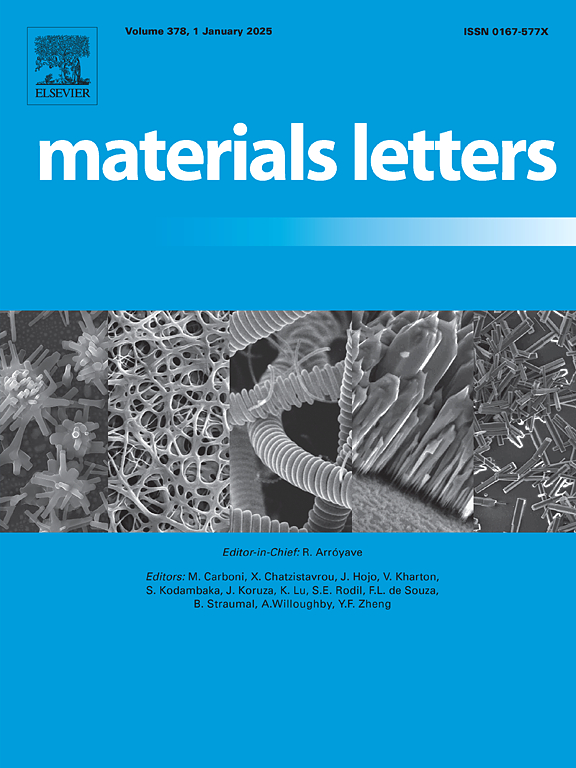Rubpy@FeTHQ conductive metal–organic framework composite for highly sensitive and selective electrochemiluminescence detection of dopamine
IF 2.7
4区 材料科学
Q3 MATERIALS SCIENCE, MULTIDISCIPLINARY
引用次数: 0
Abstract
The development of highly sensitive and selective electrochemical sensors for dopamine (Dop) detection plays a vital role in clinical diagnostics and health monitoring. While conductive metal–organic frameworks (cMOFs) are considered promising materials for such applications, their limited intrinsic redox activity restricts their performance. In this work, a novel cMOF composite (Rubpy@FeTHQ) was synthesized through the in-situ incorporation of Ru(bpy)32+ into FeTHQ. The introduction of redox-active sites and luminescent properties is achieved through functionalization with Ru(bpy)32+, resulting in synergistic enhancement of both conductivity and electrochemiluminescence (ECL) activity. This modification enables efficient dopamine detection. The Rubpy@FeTHQ sensor exhibits outstanding performance in Dop detection, achieving high linearity (R2 = 0.997) and a low detection limit (0.064 μM). Additionally, the sensor demonstrates excellent stability, reproducibility, and selectivity, with minimal interference from common biological metabolites. This study highlights the significant potential of Rubpy@FeTHQ as a robust ECL sensor for neurotransmitter detection. The developed composite material provides a scalable approach for designing multifunctional cMOFs tailored for biosensing applications, offering promising opportunities for advancements in clinical diagnostics and health monitoring.
Rubpy@FeTHQ导电金属-有机框架复合材料对多巴胺的高灵敏度和选择性电化学发光检测
高灵敏度、高选择性的电化学多巴胺传感器的开发在临床诊断和健康监测中具有重要作用。虽然导电金属有机框架(cMOFs)被认为是很有前途的材料,但它们有限的内在氧化还原活性限制了它们的性能。在这项工作中,通过在FeTHQ中原位掺入Ru(bpy)32+,合成了一种新型的cMOF复合材料(Rubpy@FeTHQ)。通过Ru(bpy)32+的功能化,引入了氧化还原活性位点和发光特性,从而协同增强了电导率和电化学发光(ECL)活性。这种修改使多巴胺检测更加有效。Rubpy@FeTHQ传感器具有良好的Dop检测性能,线性度高(R2 = 0.997),检测限低(0.064 μM)。此外,该传感器表现出优异的稳定性、可重复性和选择性,对常见生物代谢物的干扰最小。这项研究强调了Rubpy@FeTHQ作为神经递质检测的鲁棒ECL传感器的巨大潜力。所开发的复合材料为设计适合生物传感应用的多功能cMOFs提供了可扩展的方法,为临床诊断和健康监测的进步提供了有希望的机会。
本文章由计算机程序翻译,如有差异,请以英文原文为准。
求助全文
约1分钟内获得全文
求助全文
来源期刊

Materials Letters
工程技术-材料科学:综合
CiteScore
5.60
自引率
3.30%
发文量
1948
审稿时长
50 days
期刊介绍:
Materials Letters has an open access mirror journal Materials Letters: X, sharing the same aims and scope, editorial team, submission system and rigorous peer review.
Materials Letters is dedicated to publishing novel, cutting edge reports of broad interest to the materials community. The journal provides a forum for materials scientists and engineers, physicists, and chemists to rapidly communicate on the most important topics in the field of materials.
Contributions include, but are not limited to, a variety of topics such as:
• Materials - Metals and alloys, amorphous solids, ceramics, composites, polymers, semiconductors
• Applications - Structural, opto-electronic, magnetic, medical, MEMS, sensors, smart
• Characterization - Analytical, microscopy, scanning probes, nanoscopic, optical, electrical, magnetic, acoustic, spectroscopic, diffraction
• Novel Materials - Micro and nanostructures (nanowires, nanotubes, nanoparticles), nanocomposites, thin films, superlattices, quantum dots.
• Processing - Crystal growth, thin film processing, sol-gel processing, mechanical processing, assembly, nanocrystalline processing.
• Properties - Mechanical, magnetic, optical, electrical, ferroelectric, thermal, interfacial, transport, thermodynamic
• Synthesis - Quenching, solid state, solidification, solution synthesis, vapor deposition, high pressure, explosive
 求助内容:
求助内容: 应助结果提醒方式:
应助结果提醒方式:


